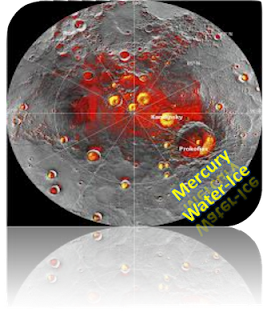New observations by the herald spaceship give convincing sustain for the long-held theory that Mercury port copious water ice and further freezing fickle resources in its enduringly outlined polar craters.
Three independent ways of facts maintain this conclusion:
The first dimensions of surplus hydrogen at Mercury's north pole among herald‘s Neutron Spectrometer, the first measurement of the reluctance of Mercury's polar places at close to ultraviolet wavelengths among the Mercury Laser Altimeter (MLA), and the first complete models of the exterior and close to external heat of Mercury's north polar constituencies that exploit the definite geography of Mercury's surface calculated by the MLA.

Herald’s advent at Mercury last year altered that. Visions from the spacecraft's Mercury twin Imaging System taken in 2011 and former this year inveterate that radar-vivid features at Mercury's north and south limits are within outlined areas on Mercury's exterior, conclude that are reliable with the water-ice theories.
Currently the latest information from emissary sturdily specify that water ice is the main ingredient of Mercury's north glacial dumps, that ice is showing at the exterior in the most icy of those places, other than that the ice is covered below an curiously dark objects cross ways most of the leaves, regions where heats are a bit too temperate for ice to be constant at the exterior itself.
Information from emissary’s Mercury Laser Altimeter (MLA) which has redundant more than 10 million laser beats at Mercury to create complete records of the planet's geography confirm the radar results and Neutron Spectrometer dimensions of Mercury's polar expanse. In a second report, that the first MLA dimensions of the outlined north Polar Regions expose unequal murky and light place at near to ultraviolet wavelength close to Mercury's North edge.
Three independent ways of facts maintain this conclusion:
The first dimensions of surplus hydrogen at Mercury's north pole among herald‘s Neutron Spectrometer, the first measurement of the reluctance of Mercury's polar places at close to ultraviolet wavelengths among the Mercury Laser Altimeter (MLA), and the first complete models of the exterior and close to external heat of Mercury's north polar constituencies that exploit the definite geography of Mercury's surface calculated by the MLA.

Herald’s advent at Mercury last year altered that. Visions from the spacecraft's Mercury twin Imaging System taken in 2011 and former this year inveterate that radar-vivid features at Mercury's north and south limits are within outlined areas on Mercury's exterior, conclude that are reliable with the water-ice theories.
Currently the latest information from emissary sturdily specify that water ice is the main ingredient of Mercury's north glacial dumps, that ice is showing at the exterior in the most icy of those places, other than that the ice is covered below an curiously dark objects cross ways most of the leaves, regions where heats are a bit too temperate for ice to be constant at the exterior itself.
Information from emissary’s Mercury Laser Altimeter (MLA) which has redundant more than 10 million laser beats at Mercury to create complete records of the planet's geography confirm the radar results and Neutron Spectrometer dimensions of Mercury's polar expanse. In a second report, that the first MLA dimensions of the outlined north Polar Regions expose unequal murky and light place at near to ultraviolet wavelength close to Mercury's North edge.




